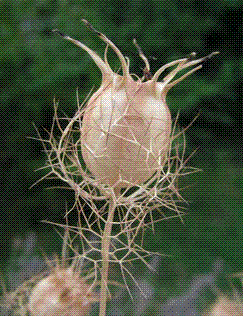The seeds of N. sativa, known as kalonji, black cumin (though this can also refer to Bunium persicum) or just nigella, are used as a spice in Indian and Middle Eastern cuisine. The dry roasted nigella seeds flavor curries, vegetables and pulses. The black seeds taste like oregano and have a bitterness to them like mustard-seeds. Most people use it as a "pepper" in recipes with pod fruit, vegetables, salads and poultry.

Onion seeds, or nigella - Kalonji
The seeds of N. sativa, known as kalonji, black cumin or just nigella, are used as a spice in Indian and Middle Eastern cuisine. The black seeds taste mostly like oregano crossed with pepper. Most people use it as a "pepper" in recipes with pod fruit, vegetables, salads and poultry. Several species are grown as ornamental plants in gardens, popular for their seed capsules, which are used in dried flower arrangements.
-Drying Nigella-
Nigella can be easily dried. Nigella is cut when pods reach maximum size and color. Nigella pods range from deep green to deep burgundy, with stripes in between. The first few pods are picked with as long a stem as possible, one at a time. The plants flowers profusely and so when most of the flowers become seed pods, pull the entire plant and cut the stems. Then wrap a rubber band around a small bundle of stems and then hang them upside down for drying in a dark, airy place until dry.
-Uses of Nigella-
Love in the mist are used exclusively for dried arrangements. These flowers are the best to add texture to any dried flower arrangement. The delicate, purple striped pods are used in several arrangements for an airy effect. Dry roasted nigella seeds flavor curries, vegetables and pulses.
They are also used to repel insects from clothes and are given to treat intestinal worms and nerve defects to reduce flatulence, and induce sweating. Dried pods are sniffed to restore a lost sense of smell.
| < Prev | Next > |
|---|
















